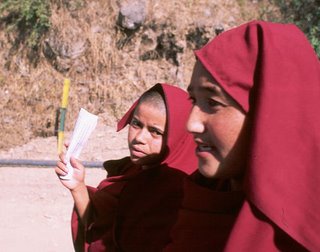Recalling To Mind The Most Recent Acts Of Chinese Violent Repression Of Religious And Peaceful Protest In Tibet
"Amnesty International today condemned a violent crackdown by
Chinese officials in Tibet which has reportedly resulted in
the shooting and serious injury of up to 80 buddhist nuns,
monks, and others. Those injured were protesting against a ban
on displaying pictures of the Dalai Lama.
It's appalling that people have been shot and severely
beaten merely for displaying pictures of their spiritual
leader," Amnesty International said. "Yet again, the Chinese
authorities have shown contempt for the Tibetan people's
human rights of freedom of religion and peaceful expression."
On 7 May, three monks from Ganden monastery, east of
Lhasa, were shot and wounded by police, some reports say that
two of them were killed. A fourth is in a serious condition
after being beaten. On 14 May two truckloads of seriously
injured people arrived at a hospital in Lhasa with a police
escort. Both incidents are thought to be related to the
increasing tension in Tibet since the authorities began to
enforce a ban on the display of pictures of the Dalai Lama in
monasteries, shops, and schools. Other monasteries are
reported to have been closed, stopping the public entering or
monks leaving without permission, in order to prevent unrest
spreading.
An eyewitness, Takeo Fujimoto, who saw two truckloads
of injured people arrive at Lhasa's main hospital on 14 May
said: "More than half were young nuns, all of them very, very
young, maybe teenagers, and one was a young girl who had been
beaten in the face. It was unbelievable."
Amnesty International is urging the Chinese authorities
to immediately release anyone detained for peacefully
expressing their beliefs and remove the ban on displaying
pictures of the Dalai Lama."
Amnesty International Index ASA 17/59/96 May 20, 2006

Tibetan Buddhist nuns participating in the annual Protest Day (protesting the Chinese occupation of Tibet). Two months ago, on May 7, 2006, the Chinese authorities in Tibet opened fire on peacefully protesting Tibetan Buddhist nuns and monks. An unknown number were killed.
Photo credit: www.flickr.com/photos/twodeadpoets/ With thanks.
*
American Composer Peter Lieberson
Ashoka’s Dream (1997)
Set to a libretto by Douglas Penick and commissioned by the Santa Fe Opera, Ashoka's Dream received its first performance in July 1997. Mark Swed, of the Los Angeles Times, wrote that Ashoka's Dream is "both splashy and stirring in its revealing of the majesty of its storytelling. The colors of the orchestra dazzle with the sonorities of great bell-like, all-encompassing chords, with rich lyrical passages and with martial orchestral conflagrations....It is music in which one feels the force of progress and senses not only its power but also the scariness of change....Ashoka's music is the most beautiful of all, and it is an inspiration to watch the complexities fall away from it as his wisdom grows."
Soloist(s) 13 Vocal Soloists: Bar, B, T, T, B, B, T, Bar, S, Mz, S, S, Mz, A
Chorus SATB chorus
Orchestration 2(pic).2.2(bcl).1+cbn/4.3(in C).2+btbn.1/timp.2perc/hp.pf/str
Chinese officials in Tibet which has reportedly resulted in
the shooting and serious injury of up to 80 buddhist nuns,
monks, and others. Those injured were protesting against a ban
on displaying pictures of the Dalai Lama.
It's appalling that people have been shot and severely
beaten merely for displaying pictures of their spiritual
leader," Amnesty International said. "Yet again, the Chinese
authorities have shown contempt for the Tibetan people's
human rights of freedom of religion and peaceful expression."
On 7 May, three monks from Ganden monastery, east of
Lhasa, were shot and wounded by police, some reports say that
two of them were killed. A fourth is in a serious condition
after being beaten. On 14 May two truckloads of seriously
injured people arrived at a hospital in Lhasa with a police
escort. Both incidents are thought to be related to the
increasing tension in Tibet since the authorities began to
enforce a ban on the display of pictures of the Dalai Lama in
monasteries, shops, and schools. Other monasteries are
reported to have been closed, stopping the public entering or
monks leaving without permission, in order to prevent unrest
spreading.
An eyewitness, Takeo Fujimoto, who saw two truckloads
of injured people arrive at Lhasa's main hospital on 14 May
said: "More than half were young nuns, all of them very, very
young, maybe teenagers, and one was a young girl who had been
beaten in the face. It was unbelievable."
Amnesty International is urging the Chinese authorities
to immediately release anyone detained for peacefully
expressing their beliefs and remove the ban on displaying
pictures of the Dalai Lama."
Amnesty International Index ASA 17/59/96 May 20, 2006

Tibetan Buddhist nuns participating in the annual Protest Day (protesting the Chinese occupation of Tibet). Two months ago, on May 7, 2006, the Chinese authorities in Tibet opened fire on peacefully protesting Tibetan Buddhist nuns and monks. An unknown number were killed.
Photo credit: www.flickr.com/photos/twodeadpoets/ With thanks.
*
American Composer Peter Lieberson
Ashoka’s Dream (1997)
Set to a libretto by Douglas Penick and commissioned by the Santa Fe Opera, Ashoka's Dream received its first performance in July 1997. Mark Swed, of the Los Angeles Times, wrote that Ashoka's Dream is "both splashy and stirring in its revealing of the majesty of its storytelling. The colors of the orchestra dazzle with the sonorities of great bell-like, all-encompassing chords, with rich lyrical passages and with martial orchestral conflagrations....It is music in which one feels the force of progress and senses not only its power but also the scariness of change....Ashoka's music is the most beautiful of all, and it is an inspiration to watch the complexities fall away from it as his wisdom grows."
Soloist(s) 13 Vocal Soloists: Bar, B, T, T, B, B, T, Bar, S, Mz, S, S, Mz, A
Chorus SATB chorus
Orchestration 2(pic).2.2(bcl).1+cbn/4.3(in C).2+btbn.1/timp.2perc/hp.pf/str


0 Comments:
Post a Comment
<< Home